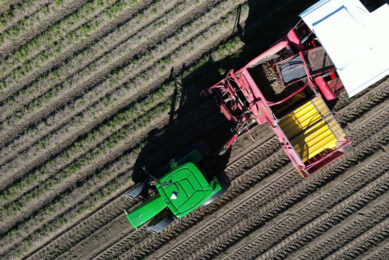High-tech beans offer cheap way to monitor grain stores

Sensors the size of beans could soon be monitoring grain stores in Europe and the US helping to slash the cost of spoilage losses. Future Farming looks at how BeanIoT performed in trials.
A small wireless sensor, roughly the size and shape of a bean, is being tested in UK grain stores to see if it will work as an early warning system to minimise storage losses. If it performs as expected, the ground-breaking development has the potential to replace handheld devices and elaborate moisture-monitoring systems currently used in stores, at a fraction of their cost.
Once they have been placed in a heap of grain, the technology-packed plastic “beans” harness the internet of things and use the power of wireless connectivity to send data to a smartphone or remote computer. When working in harmony as part of a network and communicating with other beans, they are sophisticated enough to send out a signal when they detect a problem or change in the grain, alerting the storekeeper to any issues.
With the ability to monitor temperature, humidity, air quality, a range of gases and any movement in the grain – either individually or when configured as a group – the beans also allow the user to decide what parameters or limits are measured. That means their output can be tailored to individual requirements or specific sites, bringing some much-needed flexibility to grain store monitoring.
BeanIoT’s wireless solution
Eventually, they are expected to provide a wireless solution that is within the financial reach of most farmers – given that the aim of the manufacturer is to get each device costing less than US$30 (£20).
Multiple monitoring options mean the farmer or store manager can receive a continuous flow of data on storage conditions if they want – something that could be very useful in the early stages of storage, when grain must be cooled quickly to prevent contamination, or when there are rapid changes in environmental conditions.
For much of the time that they are in situ, the beans are asleep. They awake if conditions change, taking a reading before returning to sleep. If a problem exists, they disturb their neighbours and send out wireless alerts, revealing the exact location of the problem.
Low-profile monitoring
Known as BeanIoT, the product was invented by electronics engineer Andrew Holland from his company RFMOD’s base at Swaffham Bulbeck, near Cambridge, UK. Essentially it works as a versatile low-profile monitoring device, providing real-time information on what’s going on.
“These are small wireless products, with the flexibility that allows users to turn sensors on or off,” explains Mr Holland. “They can be put into a small space, such as a shelf or a wall, and used to collect real-time information.” As such, they become a powerful proposition when used as a mesh of sensors, as they allow the user to control the immediate environment, he says.
“We have been developing BeanIot to be a secure platform for delivering big data to the internet of things. We are also working on an app that will allow the user to control and set up the beans, according to their particular needs.” Roughly the same size as a golf tee, each unit is just 45mm long and 18mm wide. Inside it has a circuit board, low-power Bluetooth radio and sensors that are able to detect motion, temperature, humidity, air pressure and the concentration of gases.
Importantly, each one also contains an electric compass and gyroscope, to help users locate them.
Retrieval challenge
Retrieving the small, reusable beans from a large heap of grain remains a challenge, testing shows. There are 2 stages where this could be possible:
- either on the farm
- or after the grain reaches a processing facility.
“These are smart beans,” continues Mr Holland. “They are constantly sending signals, so their exact location is known. We now just need to work out the best way of getting the devices back so they can be used again.”
The grain co-operative Fengrain, based near Cambridge, has been helping with some of the development work and will be testing the BeanIot again this harvest. “We have silos and flat stores, so a flexible wireless system is essential,” says business development manager Paul Randle. “Our main concern is temperature, but we’re also tracking gases and any movement in the store.”
The retrieval question could be answered by placing the beans within another container, he suggests. “Putting them in a structure similar to a plastic golf ball could work – it would be much easier to reclaim them if they were more visible.”
Join 17,000+ subscribers
Subscribe to our newsletter to stay updated about all the need-to-know content in the agricultural sector, two times a week.



